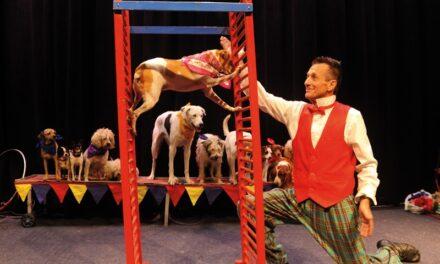The revered shepherd’s story of the first Christmas, La Gran Pastorela, returns to Socorro this Saturday, Dec. 2. The theater group Los Pastores de Belen will be performing this traditional story – entirely in Spanish – at San Miguel’s Parish Hall at 2 p.m.
It is a play, or pageant, interspersed with morality and other Christian principles in romantic prose and a bit of humor.
Presentation of the story has been a traditional part of the Christmas season in Socorro, and this year, a kids’ performance returns and will be presented on Sunday, Dec. 17 at 11:30 a.m.
According to organizer Sheri Armijo, the late Bobby Romero had been putting on La Gran Pastorela with the Knights of Columbus as far back as the 1950s.
“Back in the Seventies, the bilingual director of Socorro schools was Dolores Griego, and she and Mamie Aragon were the ones who had the idea to adapt the program and make a version for kids,” Armijo said. “Since Bobby Romero had been performing it since the Fifties, Dolores and Mamie enlisted his help to provide the music for the kids’ performance. So, it was a collaboration.”
That’s how the children’s version began. As well as overseeing the traditional version of La Gran Pastorela, Romero took on the version with elementary school children.
She said the idea for reinstatement of the youths’ version came after a suggestion from Adrianna Carilli.
“Adrianna’s children had performed in it for years, and she was really wanting us to reinstate it,” Armijo said. “And since we had kept all the materials and music like a historical archive, we started it up again for this year.”
Sheri and her husband, Ricardo Berry, have helmed the production since 2008.
La Gran Pastorela begins with the singing of traditional Spanish songs followed by the entrada of the actors from the back of the audience.
The birth of the baby Jesus is announced by Archangel Michael, which Lucifer tries in vain to discredit. When the shepherds arrive in Bethlehem, they worship the Christ child and one by one, offer their humble gifts to Mary, except the lazy Bartolo, who’d rather sleep than see the baby Jesus.
Each of the shepherds tries to wake Bartolo and finally coax him to see the Niño. When Bartolo looks upon the baby Jesus, he is overcome with emotion and guilt – shameful for ignoring the child.
Armijo said the play is one of the ways used to teach children about the Nativity.
“It’s the story of simple shepherds invited by an angel to go see the Christ child in Belen,” she said. “As the shepherds make their way to Belen, they falter with human weaknesses.”
Armijo said the play keeps the Spanish language alive in New Mexico by blending elements of Golden Age Spanish poetry and colonial New Mexico folk expressions.
“It’s a devotion first and foremost, and historically, it’s really important to me because it goes back to the Golden Age of Spain and even to Greek roots,” she said. “Some of our shepherds’ names come from Greek characters. And our chorus is like the classic Greek chorus which helps tell some of the story through songs.”
The play concludes with the singing of popular Christmas carols, such as Silent Night and Feliz Navidad, in Spanish.
Armijo said to keep it in a historical perspective, it is always performed in the original language.
“It wasn’t even written down; it was passed on orally in the beginning, and it was all archaic traditional Spanish, so there are a lot of archaic expressions and poetic expressions that would not translate well into English,” she said.
The Pastorela, as initially staged in Nuevo Mexico, could run up to three hours long.
“Our show runs about an hour and a half,” she said. “But, in the past, if you had a community sometimes where a lot of people wanted to perform, you would add in all these extra parts.”
Armijo said she has seen evidence of performances in Spain where there would be more than one demon.
“They had a Devil dance,” she said. “And San Miguel, too. He could be portrayed with a band of angels.”
Approximately 70 documented versions of the Shepherds’ play in New Mexico exist.
Historical writings cite a nativity play considered a predecessor to La Pastorela, presented in 1530 in Tlatelolco, Mexico. There was also a Coloquio de Los Pastores produced in Sinaloa in 1595.
Over time, a number of communities throughout Nuevo Mexico performed these “miracle” plays.
Using an early manuscript found in Las Nutrias in 1972, Los Pastores de Belen’s archaic Colonial Spanish presentation is not too different than a performance would have been 200 years ago.
The earliest Socorro version was in the possession of Juan Julian Torres in 1886. Torres was Socorro County Clerk from 1882 to 1886.
Anastacio Torres directed a Socorro group from the early 1900s through 1933, and in 1953, Salomon A. Apodaca, a sheepherder in the Socorro area, led a revival of the play with the Socorro Knights of Columbus.
Los Pastores de Belen has presented the play for over 30 years.
The cast members include Socorro’s Armijo in the role of Gila and her husband, Ricardo, as Lucifer.
“This would mark my 13th year of playing Gila,” Armijo said. “Gila is in charge of keeping all those men in line and making them behave.”
She also feeds them.
“All they have is mutton, but they have grandiose dreams of eating tamales, green chile stew, and desserts,” she said. “And when they ask her for those things, she gives them mutton stew again. It’s a very comical scene.”
The Belen group has traveled throughout New Mexico, and into Texas and Arizona to perform the play.
Long before books and movies, people preserved faith and culture by telling stories. La Gran Pastorela is the result of that oral tradition.
“It’s good to keep the tradition alive because it is a lesson in living history,” Armijo said.
The Friends of El Camino Real Historic Trail Site has sponsored La Pastores de Belen’s play for several years.


















